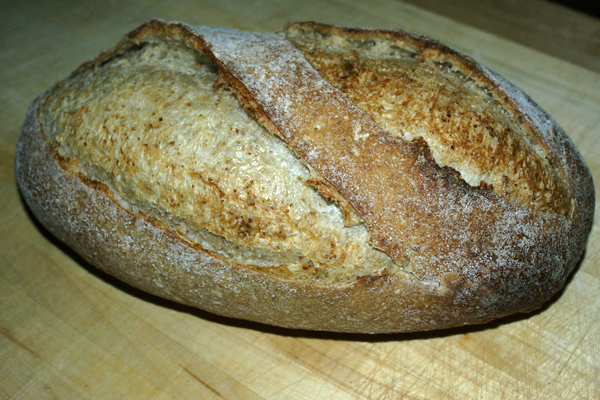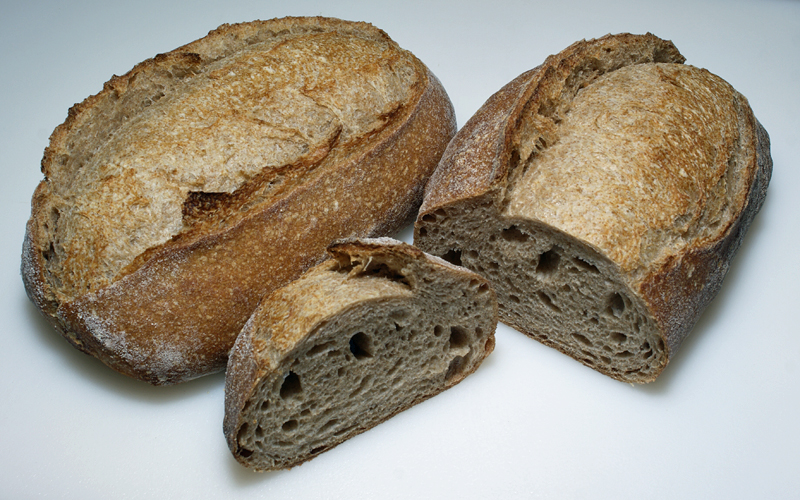Five years ago (April 25) I discovered The Fresh Loaf, and started this journey. Prior to then I’d frequently baked yeasted breads, and a modest spectrum of other baked goods. I’d bought a bread-maker—A Zo—and soon after quit, for the most part, buying supermarket bread. I continued to purchase loaves from local bakers, Deli Rye most frequently; and, while still working, loaded up with airport sourdough every time I passed through San Francisco.
I was content—well, almost content.
Over a couple of decades I’d tried half-a-dozen times to make sourdough bread at home. Every time mediocre, early successes were followed by dismal failures, and a neglected, smelly culture—sometimes rainbow colored with molds—long lurking in the depths of the refrigerator.
Mentored by TFL experts—you know who you are—to whom I will be forever grateful, during the first two years, I read a lot, experimented a lot, and had more successes than failures. And all the failures were edible.
In July of 2011 I could no longer deny a major failure was eminent.
My sourdough starter was slowly going belly-up. I tried to save it, but gave up after a time, and turned to TFL’er, Debra Wink, for help. With day-by-day guidance she led me back to having a robust, viable starter. She also suggested an alternate maintenance plan (for a refrigerated seed starter). I followed her advice, and now, nearly three years later, I am still enjoying the same culture’s robustness and dependability.
The experience got me thinking in broader chunks about my bread making. I’d started with a vague goal: I wanted to make “better bread”. I defined “better” with three parameters: good flavor, appropriate crumb, and pleasing eye-appeal. They are listed in priority order. Somewhere along the way a meta-parameter had unconsciously crept in: Consistency.
My conscious goal became make “better” bread consistently.
I can happily say I’ve reached a point in time when I can, with reasonable safety, say I’ve met my goal.
Insanity is often defined as “doing the same thing over, and over again, and expecting a different outcome. I assume the opposite is also true: “doing the same things consistently, and expecting the same outcome is sane.”
My TFL blog is, in the recent past three years, peppered with arguments for developing a personal, disciplined process(es) for baking breads. Discipline, in my opinion, begins with consistency: in ingredients, in procedures, in time and temperature, and also attitude.
This morning, while building a small amount of levain, not for baking but to merely replace my refrigerated seed starter—no baking this week, the freezer is full—I thought it worth a blog entry to focus on starter maintenance, and levain building (manipulation).
With the back-story complete, here’s what I do with my seed starter—consistently.
• 24 hours before dough making: Build 1; 40g seed starter @ 100% hydration, 20g each Flour (KA Bread Flour) and filtered well water. (2:1:1) Ferment at room temperature (72°F – 76°F)
• 16 hours before dough making: Build 2: All of Build 1, 40g flour and 40g H2O. Ferment at room temperature.
• 8 hours before dough making: Build 3: All of Build 2, 80g flour and 80g H20. Ferment at 82°F.
I make three sourdoughs routinely: a 10%:45%:45% (Rye: AP: Bread flours mix) @ 67% hydration, a Mostly White (only 5% Rye) at 67% to 72% hydration, and a 50% Whole Wheat:Bread flours version @ 68% hydration. All use 250g of ripe 100% hydrated levain. Which leaves 70g of ripe levain from the three Build process


10/45/45 Sourdough

 Mostly White Sourdough
Mostly White Sourdough

50%Whole Wheat Sourdough
I feed 50g of the remaining levain 1:1:1 with Bread flour and water, and completely replace the previous week’s seed starter. (Divided equally into two jars. I’ve always been a belt-and-suspenders, risk-avoiding guy.) I refrigerate this mix immediately. Total replacement was Debra Wink’s suggestion. Previously, I’d been feeding a measured amount of the residual seed starter. This may have contributed to (caused?) the earlier failure.
This discipline, along with 15 hours of retardation at 54°F, yields consistent performance regardless of the flour mix, or hydration. I divide and warm the chilled, retarded dough for one hour at 82°F, shape the final loaves, and return them to the proofing box (82°F). Proofing invariably takes 2 hours and 15 to 20 minutes. I bake at 450°F, with steam for 15 minutes, and without steam until internal temperature reaches 208°F to 212°F—typically 8 to 10 more minutes for 1 lb. loaves and 12 to 15 more minutes for 1.5 lb loaves regardless of dough type or hydration percentage.
Variations on the theme:
• I’ve built a Rye Sour beginning with the same seed starter, but now replaced every week to ten days; otherwise same process: surplus Rye Sour for baking is fed at 1:1:1 with Whole Rye and stored in the refrigerator.
However, I build Rye levain at 60% hydration for the first 16 hours (Two progressive builds @ Room Temp.) and 100% Hydration at 82°F for Build 3.
• My wife is not a sour, sourdough fan. Consequently, I focus sourdough builds on yeast, not bacteria development. (82°F is the sweet spot for yeast development).
• When I want more tang, I let builds 1 and 2 go 12 to 16 hours fermentation. If I want even more I push build 3’s temperature to 90°F.
I thought this blog might stimulate other TFL’ers to share their personalized processes leading to their successes. The emphasis is on how we achieve succeed.
Happy Baking,
David G
- davidg618's Blog
- Log in or register to post comments
David,
I really enjoyed reading your post. Congratulations on arriving at a point where you are consistently making good breads. It takes patience, repetition, and time. Often, my advice to people who are just starting out on a bread making journey is to pick a loaf they like and work on it until they have mastered it. That is because there is so much to be learned from making the same loaf over and over again. No two results will ever be the same unless you are working in a sterilized, climate controlled environment with robots doing the dividing, shaping and slashing.
Your breads look excellent. Nice open crumb. Really good, shaping, proofing and slashing.
I also keep two jars of starter for the same reason as you: insurance!
All the best,
Syd
After my early flutter of experiments that's exactly what I did. For about a year I baked only one sourdough formula, and one baguette formula. When I tweaked a formula I (for the most part:-) ) only tweaked one ingredient, measurement or procedure at a time. As time has passed I've added variations, but always with the same attitude. Most recently I been working on a sandwich Rye loaf. The last two loaves, baked a week apart, were twins, and I think I've settled on its formula which includes Mini's coriander, fennel and caraway spice mix.
Thanks for the kind words.
David G
3 progressively larger feedings are the way to get a cold starter up and ready to do the job. We like sour around here, at least Lucy and i do, so keep 125 g of rye starter in the fridge for 6 weeks and bake with it over that time but only use, at most, 10 g - 25 g of seed to make the 3 stage levain for the weekly bakes. Our loaves are pretty small at 800 g of flour and water. We build the exact amount of levain we want for each bake around 10-20% of the total flour and water in the loaf depending on how long we want the retard at 36 F to be and how sour we want the bread to end up
When we get down to 20 g or so we refresh the whole thing over 3 progressively larger feedings and cu the water on the 3rd one to get the hydration to 66% and refrigerate it when the starter rises 25% after the 3rd feeding. As the weeks pass the starter makes progressively more sour bread. by doing the out of fridge work at 92 F, the temperature the LAB like best rather than the yeast at 82 F.
Your process make complete sense to me for bread that is less sour than ours.
Thanks for the post I'm sure it will help many David
Likewise, your approach makes sense to me for a more sour levain. I intentionally bake Rye bread at ten day intervals, allowing my Rye Sour to have a bit longer than a week to develop flavor. I also build Rye levain differently than I do Bread flour fed levain.
I keep my Rye Sour stored at 100% hydration, but I manipulate the three builds differently. For build 1 I convert the hydration to 60%, and ferment for eight hours at room temperature. Build 2 (which doubles the weight from Build 1) is also maintained at 60% hydration and fermented at room temperature. For Build 3 (again doubling) I restore the developing levain to 100% hydration, and ferment for a final eight hours at 82°F. All builds, and the seed starter are only fed with Whole Rye. The first two build are meant to develop flavor, and the final build favoring yeast development.
That's as far as I am willing to push the levain sour. My wife is developing a liking for mt sandwich Rye bread, but I'm taking it slowly. She loves Mini's spice mix. I make a 1.5lb loaf (750g of dough) with 2 tsp. each of caraway, fennel and coriander: toasted and coarsely ground just before mixing with the dough.
David G
Very informative and enjoyable post. Congratulations on your diligence and your success.
Glad you found it informing.
Happy Baking,
David G